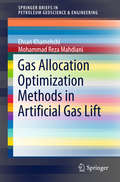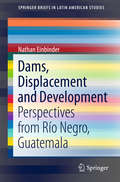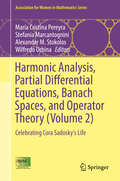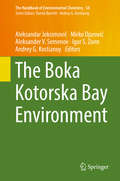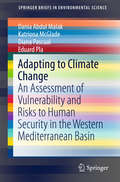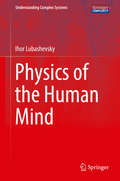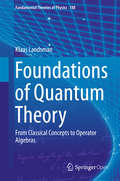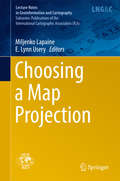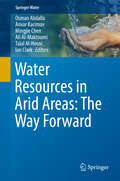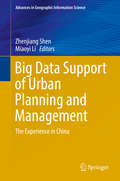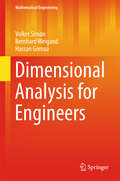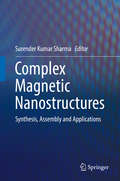- Table View
- List View
Gas Allocation Optimization Methods in Artificial Gas Lift (SpringerBriefs in Petroleum Geoscience & Engineering)
by Ehsan Khamehchi Mohammad Reza MahdianiThis Brief offers a comprehensive study covering the different aspects of gas allocation optimization in petroleum engineering. It contains different methods of defining the fitness function, dealing with constraints and selecting the optimizer; in each chapter a detailed literature review is included which covers older and important studies as well as recent publications. This book will be of use for production engineers and students interested in gas lift optimization.
Quantum Spin Systems on Infinite Lattices: A Concise Introduction (Lecture Notes in Physics #933)
by Pieter NaaijkensThis course-based primer offers readers a concise introduction to the description of quantum mechanical systems with infinitely many degrees of freedom – and quantum spin systems in particular – using the operator algebraic approach. Here, the observables are modeled using elements of some operator algebra, usually a C*-algebra. This text introduces readers to the framework and the necessary mathematical tools without assuming much mathematical background, making it more accessible than advanced monographs. The book also highlights the usefulness of the so-called thermodynamic limit of quantum spin systems, which is the limit of infinite system size. For example, this makes it possible to clearly distinguish between local and global properties, without having to keep track of the system size. Together with Lieb-Robinson bounds, which play a similar role in quantum spin systems to that of the speed of light in relativistic theories, this approach allows ideas from relativistic field theories to be implemented in a quantum spin system. Several related cases are discussed, demonstrating the merits of the operator algebraic approach. Featuring representative worked-out examples and many exercises, this text is primarily targeted at graduate students and advanced undergraduates in theoretical physics or mathematics with a keen interest in mathematical physics. The material provides the necessary background and pointers to start exploring the recent literature. As such, it will also be useful for active researchers seeking a quick and comparatively self-contained introduction to the operator algebraic approach to quantum spin systems.
Dams, Displacement and Development: Perspectives from Río Negro, Guatemala (SpringerBriefs in Latin American Studies)
by Nathan EinbinderUsing the case of the Chixoy Hydroelectric Dam in Guatemala, constructed between 1978 and 1983, this book examines the effects of displacement on the former residents of Río Negro, a community forcibly evicted and nearly eliminated by the military and paramilitary. Using open-ended interview discussions and testimonies, it focuses on this specific incident of displacement and violence and discusses the outcomes 30 years later. Guatemala’s history is plagued by development projects that resulted in displacement, violence, and increased marginalization of its indigenous and non-indigenous populations. In order to make way for development initiatives such as the production of bananas, African palm, coffee and sugar cane; the extraction of metals such as gold and nickel; or, in this specific case, the construction of a hydroelectric dam, the land-based, predominately Maya campesinos have been systematically uprooted from the lands of their birth and launched into uncertainty.The research findings presented, based on fieldwork conducted from January to April 2009, suggest that the majority of survivors from the massacres that took place are still adversely affected by the destruction of their families and livelihoods. While the circumstances pertaining to this event are unique, similar struggles over land and human rights continue into the present — and if policies remain unchanged, in both international development agencies as well as the Guatemalan government, clashes of this nature only increase in time.
Renewable Energy: Problems and Prospects in Coachella Valley, California (SpringerBriefs in Geography)
by James B. PickThe book analyzes the problems and potential of renewable energy development for the Coachella Valley of California and provides a useful case study for renewable energy feasibility assessments for other areas. A conceptual model, Integrated Policy Assessment Theory for Renewable Energy, is given and justified for renewable energy development in the Valley. Further, Central Place Theory, well known in urban geography, is discussed and it is seen to be very relevant to the understanding the Coachella Valley’s city sizes and renewable energy markets, compared to the greater Los Angeles region. The book’s research methods include geospatial mapping and analysis and interviews leaders in small innovative firms, government agencies, and nonprofits. The many findings of the book include evaluation of how the Valley’s socioeconomic and transportation features influence renewable energy development, the scope of markets for solar and wind energy in the Valley, spatial confluences of renewable energy facilities with other features, and the future potential of ground-source heat pumps. Benchmark comparison of the Coachella Valley is done with two leading wind and solar regions elsewhere in the country, to assess the Valley’s evolution and opportunities in renewable energy. The book concludes by evaluating the prospects and problems for the growth of renewable entrepreneurship, manufacturing, assembly, and operations in Coachella Valley. This leads to policy recommendations grounded in the book’s research findings, which are intended for use by governments, businesses, and nonprofits. The hope is that many of the developmental experiences from the Coachella Valley will be helpful not only within the Valley but to other communities nationwide and worldwide.
Geodynamics of the Latin American Pacific Margin (Pageoph Topical Volumes)
by William L. Bandy Juanjo Dañobeitia Carlos Mortera Gutiérrez Yuri Taran Rafael BartoloméGeodynamics of the Latin American Pacific Margin presents a collection of 22 studies by a multinational group of investigators whose common interest is to better understand the complex geodynamic processes occurring along the Pacific margin of Latin America and the impact that these processes have on the local populace. Processes investigated in these papers include the subduction of buoyant ridges and spreading centers, ophiolite emplacement, plate margin truncation, forearc deformation, mantle convection, magma emplacement and associated continental rifting, and the release of energy by great earthquakes as well as slow slip events. These studies illustrate the vast and varied research opportunities that exist along the margin, and will be a welcome addition to the library of those who are actively investigating the geodynamics of the Latin American Pacific margin as well as those interested in the subduction process in general.
Non-equilibrium Statistical Physics with Application to Disordered Systems
by Manuel Osvaldo CáceresThis textbook is the result of the enhancement of several courses on non-equilibrium statistics, stochastic processes, stochastic differential equations, anomalous diffusion and disorder. The target audience includes students of physics, mathematics, biology, chemistry, and engineering at undergraduate and graduate level with a grasp of the basic elements of mathematics and physics of the fourth year of a typical undergraduate course. The little-known physical and mathematical concepts are described in sections and specific exercises throughout the text, as well as in appendices. Physical-mathematical motivation is the main driving force for the development of this text. It presents the academic topics of probability theory and stochastic processes as well as new educational aspects in the presentation of non-equilibrium statistical theory and stochastic differential equations.. In particular it discusses the problem of irreversibility in that context and the dynamics of Fokker-Planck. An introduction on fluctuations around metastable and unstable points are given. It also describes relaxation theory of non-stationary Markov periodic in time systems. The theory of finite and infinite transport in disordered networks, with a discussion of the issue of anomalous diffusion is introduced. Further, it provides the basis for establishing the relationship between quantum aspects of the theory of linear response and the calculation of diffusion coefficients in amorphous systems.
Harmonic Analysis, Partial Differential Equations, Banach Spaces, and Operator Theory: Celebrating Cora Sadosky's Life (Association for Women in Mathematics Series #5)
by María Cristina Pereyra Stefania Marcantognini Alexander M. Stokolos Wilfredo UrbinaThis book is the second of a two volume series. Covering a range of subjects from operator theory and classical harmonic analysis to Banach space theory, this book features fully-refereed, high-quality papers exploring new results and trends in weighted norm inequalities, Schur-Agler class functions, complex analysis, dynamical systems, and dyadic harmonic analysis. Graduate students and researchers in analysis will find inspiration in the articles collected in this volume, which emphasize the remarkable connections between harmonic analysis and operator theory. A survey of the two weight problem for the Hilbert transform and an expository article on the Clark model to the case of non-singular measures and applications to the study of rank-one perturbations are included. The material for this volume is based on the 13th New Mexico Analysis Seminar held at the University of New Mexico, April 3-4, 2014 and on several special sections of the Western Spring Sectional Meeting at the University of New Mexico, April 4-6,2014. During the event, participants honored the memory of Cora Sadosky—a great mathematician who recently passed away and who made significant contributions to the field of harmonic analysis. Cora was an exceptional scientist and human being. She was a world expert in harmonic analysis and operator theory, publishing over fifty-five research papers and authoring a major textbook in the field. Participants of the conference include new and senior researchers, recent doctorates as well as leading experts in the area.
The Boka Kotorska Bay Environment (The Handbook of Environmental Chemistry #54)
by Aleksandar Joksimović Mirko Djurović Aleksander V. Semenov Igor S. Zonn Andrey G. KostianoyThis book focuses on environmental aspects of Boka Kotorska Bay in Montenegro (South Adriatic Sea), an area that has been shaped by seasonal tourism, and explores the use and limitations of its natural resources. The individual chapters highlight its geographic and oceanographic characteristics, climate, history and development, biology, fisheries, agriculture, coastal zones, shipping, marine tourism and pollution. Above all, the environmental impact of tourism on marine, coastal and shoreline areas and the resulting conflicts are discussed in detail. The volume is intended for specialists working in various fields of environmental sciences and ecology, water resources and management, land reclamation and agriculture, and regional climate change.
Citizen Empowered Mapping (Geotechnologies and the Environment #18)
by Michael Leitner Jamal Jokar ArsanjaniThis book promotes the exploitation of novel and emerging approaches for mapping environmental and urban informatics empowered by citizens. Chapters are grouped in three sections representing the main subjects. The first section describes data acquisition and modeling. The second section focuses on the quality and reliability of data. The final section presents different methods of environmental monitoring and perception. The book includes diverse case studies from Mexico, the United States and Czech Republic.Topics covered in Citizen Empowered Mapping are of interest for research scholars, practitioners, postgraduates, and professionals from a variety of disciplines including geography, environmental science, geographic information science, social science, and computer science.
Inverse Problems for Partial Differential Equations (Applied Mathematical Sciences #127)
by Victor IsakovA comprehensive description of the current theoretical and numerical aspects of inverse problems in partial differential equations. Applications include recovery of inclusions from anomalies of their gravity fields, reconstruction of the interior of the human body from exterior electrical, ultrasonic, and magnetic measurement. By presenting the data in a readable and informative manner, the book introduces both scientific and engineering researchers as well as graduate students to the significant work done in this area in recent years, relating it to broader themes in mathematical analysis.
Adapting to Climate Change: An Assessment of Vulnerability and Risks to Human Security in the Western Mediterranean Basin (SpringerBriefs in Environmental Science)
by Dania Abdul Malak Katriona McGlade Diana Pascual Eduard PlaThis book examines the water-related impacts of climate change in the UNESCO Intercontinental Biosphere Reserve of the Mediterranean (IBRM) straddling Spain and Morocco. This is the first in-depth publication on a fascinating transboundary case study; while climate change effects are rather homogenous across the IBRM, differing socio-economic contexts, land-use patterns and policy frameworks in Spain and Morocco mean considerable variations in vulnerability and consequences for human security. The authors have produced a novel and integrated vulnerability assessment that combines hydro-ecological, socio-economic and policy analyses. The interdisciplinary approach and insights contained in this volume will appeal both to those interested in the integration of natural and social sciences as well as those working on water and climate change from academic, practical or policy-oriented perspectives.
Physics of the Human Mind (Understanding Complex Systems)
by Ihor LubashevskyThis book tackles the challenging question which mathematical formalisms and possibly new physical notions should be developed for quantitatively describing human cognition and behavior, in addition to the ones already developed in the physical and cognitive sciences.Indeed, physics is widely used in modeling social systems, where, in particular, new branches of science such as sociophysics and econophysics have arisen. However, many if not most characteristic features of humans like willingness, emotions, memory, future prediction, and moral norms, to name but a few, are not yet properly reflected in the paradigms of physical thought and theory. The choice of a relevant formalism for modeling mental phenomena requires the comprehension of the general philosophical questions related to the mind-body problem. Plausible answers to these questions are investigated and reviewed, notions and concepts to be used or to be taken into account are developed and some challenging questions are posed as open problems. This text addresses theoretical physicists and neuroscientists modeling any systems and processes where human factors play a crucial role, philosophers interested in applying philosophical concepts to the construction of mathematical models, and the mathematically oriented psychologists and sociologists, whose research is fundamentally related to modeling mental processes.
Introduction to Complex Theory of Differential Equations (Frontiers in Mathematics)
by Anton Savin Boris SterninThis book discusses the complex theory of differential equations or more precisely, the theory of differential equations on complex-analytic manifolds. Although the theory of differential equations on real manifolds is well known – it is described in thousands of papers and its usefulness requires no comments or explanations – to date specialists on differential equations have not focused on the complex theory of partial differential equations. However, as well as being remarkably beautiful, this theory can be used to solve a number of problems in real theory, for instance, the Poincaré balayage problem and the mother body problem in geophysics. The monograph does not require readers to be familiar with advanced notions in complex analysis, differential equations, or topology. With its numerous examples and exercises, it appeals to advanced undergraduate and graduate students, and also to researchers wanting to familiarize themselves with the subject.
Foundations of Quantum Theory: From Classical Concepts to Operator Algebras (Fundamental Theories of Physics #188)
by Klaas LandsmanThis book studies the foundations of quantum theory through its relationship to classical physics. This idea goes back to the Copenhagen Interpretation (in the original version due to Bohr and Heisenberg), which the author relates to the mathematical formalism of operator algebras originally created by von Neumann. The book therefore includes comprehensive appendices on functional analysis and C*-algebras, as well as a briefer one on logic, category theory, and topos theory. Matters of foundational as well as mathematical interest that are covered in detail include symmetry (and its "spontaneous" breaking), the measurement problem, the Kochen-Specker, Free Will, and Bell Theorems, the Kadison-Singer conjecture, quantization, indistinguishable particles, the quantum theory of large systems, and quantum logic, the latter in connection with the topos approach to quantum theory.This book is Open Access under a CC BY licence.
Choosing a Map Projection (Lecture Notes in Geoinformation and Cartography)
by Miljenko Lapaine E. Lynn UseryThis book offers a much-needed critical approach to the intelligent use of the wide variety of map projections that are rapidly and inexpensively available today. It also discusses the distortions that are immanent in any map projection. A well-chosen map projection is one in which extreme distortions are smaller than those in any other projection used to map the same area and in which the map properties match its purpose. Written by leading experts in the field, including W. Tobler, F.C. Kessler, S.E. Battersby, M.P. Finn, K.C. Clarke, V.S. Tikunov, H. Hargitai, B. Jenny and N. Frančula. This book is designed for use by laymen. The book editors are M. Lapaine and E.L. Usery, Chair and Vice-Chair, respectively, of the ICA Commission on Map Projections for the period 2011-2015.
Global Changes and Natural Disaster Management: Geo-information Technologies
by Saied Pirasteh Jonathan LiThis book presents ongoing research and ideas related to earth observations and global change, natural hazards and disaster management studies, with respect to geospatial information technology, remote sensing, and global navigation satellite systems. Readers will discover uses of advanced geospatial tools, spatiotemporal models, and earth observation systems. Chapters identify the international aspects of the coupled social, land and climate systems in global change studies, and consider such global challenges as agriculture monitoring, the smart city, and risk assessment.The work presented here has been carefully selected, edited, and peer reviewed in order to advance research and development, as well as to encourage innovative applications of Geomatics technologies in global change studies. The book will appeal not only to academicians, but also to professionals, politicians and decision makers who wish to learn from the very latest and most innovative, quality research in this area of global change and natural disaster management.Contributions are drawn from revised submissions based on state-of-the-art papers from the 7th GiT4NDM - 5th EOGC, 2015 event.
Water Resources in Arid Areas: The Way Forward (Springer Water)
by Osman Abdalla Anvar Kacimov Mingjie Chen Ali Al-Maktoumi Talal Al-Hosni Ian ClarkThis book presents the most recent innovations, trends, concerns and practical challenges, and solutions in the field of water resources for arid areas. It gathers outstanding contributions presented at the International Water Conference on Water Resources in Arid Areas (IWC 2016), which was held in Muscat, Oman in March 2016. The individual papers discuss challenges and solutions to alleviate water resource scarcity in arid areas, including water resources management, the introduction of modern irrigation systems, natural groundwater recharge, construction of dams for artificial recharge, use of treated wastewater, and desalination technologies. As such, the book provides a platform for the exchange of recent advances in water resources science and research, which are essential to improving the critical water situation
Predictability of Chaotic Dynamics: A Finite-time Lyapunov Exponents Approach (Springer Series in Synergetics)
by Juan C. Vallejo Miguel A. SanjuanThis book is primarily concerned with the computational aspects of predictability of dynamical systems – in particular those where observation, modeling and computation are strongly interdependent. Unlike with physical systems under control in laboratories, for instance in celestial mechanics, one is confronted with the observation and modeling of systems without the possibility of altering the key parameters of the objects studied. Therefore, the numerical simulations offer an essential tool for analyzing these systems. With the widespread use of computer simulations to solve complex dynamical systems, the reliability of the numerical calculations is of ever-increasing interest and importance. This reliability is directly related to the regularity and instability properties of the modeled flow. In this interdisciplinary scenario, the underlying physics provide the simulated models, nonlinear dynamics provides their chaoticity and instability properties, and the computer sciences provide the actual numerical implementation. This book introduces and explores precisely this link between the models and their predictability characterization based on concepts derived from the field of nonlinear dynamics, with a focus on the finite-time Lyapunov exponents approach. The method is illustrated using a number of well-known continuous dynamical systems, including the Contopoulos, Hénon-Heiles and Rössler systems. To help students and newcomers quickly learn to apply these techniques, the appendix provides descriptions of the algorithms used throughout the text and details how to implement them in order to solve a given continuous dynamical system.
The Philippine Archipelago (Springer Geography)
by Yves BoquetThis book presents an updated view of the Philippines, focusing on thematic issues rather than a description region by region. Topics include typhoons, population growth, economic difficulties, agrarian reform, migration as an economic strategy, the growth of Manila, the Muslim question in Mindanao, the South China Sea tensions with China and the challenges of risk, vulnerability and sustainable development.
Big Data Support of Urban Planning and Management: The Experience in China (Advances in Geographic Information Science)
by Zhenjiang Shen Miaoyi LiIn the era of big data, this book explores the new challenges of urban-rural planning and management from a practical perspective based on a multidisciplinary project. Researchers as contributors to this book have accomplished their projects by using big data and relevant data mining technologies for investigating the possibilities of big data, such as that obtained through cell phones, social network systems and smart cards instead of conventional survey data for urban planning support. This book showcases active researchers who share their experiences and ideas on human mobility, accessibility and recognition of places, connectivity of transportation and urban structure in order to provide effective analytic and forecasting tools for smart city planning and design solutions in China.
Mediascape and The State: A Geographical Interpretation of Image Politics in Uttar Pradesh, India (Springer Geography)
by Shekh MoinuddinThis book investigates image politics during elections and how the political discourse is reflected during the Uttar Pradesh assembly elections in 2012 by the media and the state. It reveals new dimensions of media geography in India and makes image construction and interpretation easy to comprehend. This interdisciplinary approach is located at the interface of geography with social, political, cultural, and media sciences. The book draws a geographical interpretation of politics to reveal the role of both media and the state to shape the political discourse with special focus on the privileged position of the “heartland” Uttar Pradesh in Indian politics. It studies the “mediascape” by highlighting application of media in both public and private spheres and discussing the importance of both old and new media, e.g., print, radio, TV, social media. Several crucial aspects are discussed and answered. How do media and politicians construct politics around the issue of minorities? How do media communalize issues during the election campaign? How can local issues gain national importance and shape national politics? This book appeals to scientists but also to graduates and postgraduates that want to understand the way image politics are performed.
Dimensional Analysis for Engineers (Mathematical Engineering)
by Volker Simon Bernhard Weigand Hassan GomaaThis monograph provides the fundamentals of dimensional analysis and illustrates the method by numerous examples for a wide spectrum of applications in engineering. The book covers thoroughly the fundamental definitions and the Buckingham theorem, as well as the choice of the system of basic units. The authors also include a presentation of model theory and similarity solutions. The target audience primarily comprises researchers and practitioners but the book may also be suitable as a textbook at university level.
Shocks, Singularities and Oscillations in Nonlinear Optics and Fluid Mechanics (Springer INdAM Series #17)
by Ferruccio Colombini Daniele Del Santo David LannesThe book collects the most relevant results from the INdAM Workshop "Shocks, Singularities and Oscillations in Nonlinear Optics and Fluid Mechanics" held in Rome, September 14-18, 2015. The contributions discuss recent major advances in the study of nonlinear hyperbolic systems, addressing general theoretical issues such as symmetrizability, singularities, low regularity or dispersive perturbations. It also investigates several physical phenomena where such systems are relevant, such as nonlinear optics, shock theory (stability, relaxation) and fluid mechanics (boundary layers, water waves, Euler equations, geophysical flows, etc.). It is a valuable resource for researchers in these fields.
Geothermics: Heat Flow in the Lithosphere (SpringerBriefs in Earth Sciences)
by Vincenzo Pasquale Massimo Verdoya Paolo ChiozziThis book, now in its second edition, offers a comprehensive and modern treatment on the background knowledge of heat transfer processes in the lithosphere. In the light of the success of the first edition, several chapters of the book have been revised and the book has been enriched with a new chapter on geothermal methods used for the inference of past climate changes.The book starts with a brief review of global tectonics and of the structure of the crust and upper mantle. Then the theory of heat conduction as well as the thermal properties and the methods for the determination of thermal conductivity and radiogenic heat are introduced. Subsequently the geothermal flow and the thermal state of the lithosphere and deep interior are analyzed. The formation, upwelling mechanisms, solidification and cooling of magmas, which can be a fundamental heat source in many geothermal systems, are reviewed. Analytical methods used for gaining information on heat and groundwater flow from the analyses of temperature depth data are also covered. Data and practical examples are supplied to facilitate the understanding of the different topics.The book is intended for Earth science graduate students and researchers.
Complex Magnetic Nanostructures: Synthesis, Assembly and Applications
by Surender Kumar SharmaThis book offers a detailed discussion of the complex magnetic behavior of magnetic nanosystems, with its myriad of geometries (e.g. core-shell, heterodimer and dumbbell) and its different applications. It provides a broad overview of the numerous current studies concerned with magnetic nanoparticles, presenting key examples and an in-depth examination of the cutting-edge developments in this field. This contributed volume shares the latest developments in nanomagnetism with a wide audience: from upper undergraduate and graduate students to advanced specialists in both academia and industry. The first three chapters serve as a primer to the more advanced content found later in the book, making it an ideal introductory text for researchers starting in this field. It provides a forum for the critical evaluation of many aspects of complex nanomagnetism that are at the forefront of nanoscience today. It also presents highlights from the extensive literature on the topic, including the latest research in this field.
